Abstract
In the last five years, the female labor force has increased rapidly in Saudi Arabia. This is due to the new government’s vision to empower women. For many decades, Saudi females were excluded from working in certain fields due to cultural restrictions. Nowadays, Saudi women are not only joining the service workforce but are currently employed in more physically demanding careers, such as manufacturing and military jobs, which were previously dominated by males. It becomes necessary to design workplaces, tools, and equipment to safely accommodate the female physical attributes, which include body dimensions. This study presents the anthropometric measurements of Saudi Arabian adult females. In total, 504 female subjects aged 20–70 participated in the study. Thirty-eight body measurements, including weight and triceps skinfold, were taken in sitting and standing postures. The main contribution of this study is to provide a national anthropometric database of Saudi females, which is very limited, especially for females in the age groups under study. The availability of such data will allow foreign and local manufacturers to design usable and safe products and workspaces for a wide range of Saudi adult females. The findings reveal that there are no significant differences in the body dimensions of Saudi females across all age groups, except for stature height, eye height, chest depth, skinfold (mm), sitting height, buttock–knee length, and hip breadth. The study also reveals that Saudi females’ body sizes are different from other Asian, Middle Eastern, and British nations, which invalidates the assumption of using other nations’ body measurements to estimate Saudis’ body measurements. Utilizing the supermarket cashier workstation to assess the appropriateness of commercial station fit for Saudi females’ body dimensions, the results underscore the crucial role of anthropometric measurements in addressing differences between product design and the unique body dimensions of Saudi females. The identified anthropometric mismatch highlights potential risks, emphasizing the threat to the working safety of Saudi females. Moreover, the data can be used by health professionals as a base to evaluate the health of Saudi adult females. Descriptive statistics and extreme values are determined. The data are presented in standard anthropometric tables.
1. Introduction
Anthropometry refers to the measurements of the human body dimensions, which can be taken either in static or dynamic states [1,2]. Anthropometric data are essential, as they provide designers with knowledge of the user’s physical dimensions to propose design solutions that fulfill users’ needs [3]. Effective design for high performance and productivity can be achieved by utilizing anthropometric data [4]. The availability of such data is essential for products as well as people-centered spatial design. These data are used to develop adjustment range mechanisms for tools to meet the needs of different users [5,6].
In recent years, anthropometry has been used to design safe and comfortable workplaces and products [7,8]. Employing anthropometry may enhance the well-being of the human body [9]. Health problems such as musculoskeletal disorders are one of the major consequences of mismatching tool dimensions and anthropometric measurements [10,11]. Improper machine and equipment design could increase the chance of work-related injuries and lower work performance [12]. The need for anthropometric data, especially for females, was highly manifested during the COVID-19 pandemic. Women health workers suffered from personal protective equipment (PPE) lack of fit, as this PPE is usually designed for males. According to the Women in Global Health survey [13], more than 85% of female health workers during the pandemic reported that their PPE was not properly designed to fit their bodies, which put them at risk of catching the virus or hindered their work.
Global product design presents challenges for designers, as products should fit humans around the globe under different environmental operations. Various studies have investigated the impact of body measurements on the design of products/workstations. For example, Wang et al. [14] collected anthropometry data from Taiwanese workers and developed standardized dimensions for workplace layout planning. Hanson et al. [15] presented the utilization of anthropometry for a workplace design application in Sweden.
The recent literature has extensively explored women’s anthropometry in the context of minimizing adverse occupational health outcomes. Studies such as [16] have focused on addressing the mismatch of workplace height for manual handling, utilizing female anthropometric measures to reduce musculoskeletal disorders. The design of manual tools for various occupations, including farming [17], hand looming [18], dentistry [19], and packaging [20], has integrated women’s anthropometry to mitigate fatigue and biomechanical stresses. Furthermore, the application of anthropometric measurements extends beyond civilian occupations to active duty, where studies [21,22,23,24] have utilized female anthropometric data to design ergonomic body armor tailored to their body measurements, enhancing battlefield operational performance. Additionally, investigations into the work routines of females, including the impact of rotating shifts on body dimensions [25], contribute to a comprehensive understanding of the intersection between anthropometry and women’s occupational health.
New trends of research consider human anthropometry in product design and evaluation of the product design lifecycle, such as in the areas of protective equipment and school furniture [26,27]. With the advancement of the industry 4.0 work environment, researchers have started to explore anthropometric data for different applications, such as touch screen information systems design [28], potential employee selection [29], and ergonomic product determination [30].
Anthropometric data are expected to be different among races and nationalities [31]. For that, anthropometric data should be available for different populations varying in gender, age, and ethnicity. Acquiring anthropometrics for a specific population is very challenging, as it is usually collected voluntarily, and it is hard to find enough subjects who are willing to participate. There have been many attempts to report national anthropometric data by different researchers from the United States [32], Britain [33], Turkey [34], Taiwan [35], Poland [36], Singapore and Indonesia [37,38], Sweden [15], Uganda [39], Iran [10], Malaysia [40], and many more.
There have been few attempts to develop international databases to provide anthropometric measurements for product design, such as the Civilian American and European Surface Anthropometry Resource Project (CAESAR) and the World Engineering Anthropometry Resource (WEAR). While CEASAR charges high fees to access the data, WEAR requires a subscription. Moreover, the International Organization for Standardization (ISO7250) published a technical report that includes basic human body measurements for technological design from different countries worldwide [41]. These databases are limited and need continuous updates to describe the body dimensions of the future generation. To decrease the efforts of collecting a comprehensive anthropometric database, new techniques are developed to create a database for a particular population based only on a few available body measurements, presented as percentiles [42].
For many years, Saudi females’ workforce participation was very minimal, especially in the manufacturing sector, which was mainly dominated by their male counterparts. In recent years, the participation of women in the workforce has increased rapidly due to government policies to empower women. As of the third quarter of 2022, Saudi females comprised 37 percent of the total workforce according to the General Authority for Statistics [43]. This figure has more than doubled in the last five years.
Saudi Arabia is like other countries in the region, with few anthropometric studies. Examples of anthropometric studies in the region include research from Saudi Arabia [44,45,46,47], Qatar [48], and Bahrain [49]. The objective of this research is to present anthropometric data on women in Saudi Arabia. The sample covers a wide range of women aged 20–70 years. The data is expected to be utilized by designers and engineers to design safe and efficient products and equipment suitable for Saudi females. Moreover, triceps skinfold measurement is surveyed to mark the health of Saudi females.
2. Materials and Methods
2.1. Participants
The participants were recruited from Riyadh, the capital of Saudi Arabia. It is the highest populated city and the main financial and government hub of the country. The city is assumed to represent the country’s demographics, as it is a mixture of Saudis who moved from different regions to Riyadh seeking job opportunities. It was difficult to recruit participants voluntarily, as women were very hesitant to reveal their body sizes. The participants were solicited by visiting different work facilities, such as hospitals, banks, grocery stores, universities, restaurants, households, etc. The randomness of the sample was sought as much as possible. However, some subjects, especially older participants, were selected to complete the data set of all possible categories under study. Inclusion criteria included participants who have not experienced any neuromuscular disease or injury and had no recent or ongoing hand or upper-limb injury nor any normal mobility problems. Before the study, ethical clearance was obtained from the Institutional Review Board at Alfaisal University.
The data were collected from women between 20 and 70 years old. The sample is divided into 4 different age groups (20–29, 30–39, 40–49, and 50–70). A total of 504 subjects participated in the study, with 126 subjects for each age group range being selected for measurement.
2.2. Sample Size
The determination of the sample size follows the procedures outlined in the International Organization for Standardization (ISO) 15535—General Requirements for Establishing Anthropometric Databases [50], as illustrated in Equations (1) and (2).
where N represents the number of individuals in the sample, CV is the coefficient of variance, and α denotes the desired percentage of relative accuracy. Given the fixed number of individuals (N = 126) in this study due to sampling limitations, the percentage of relative accuracy can be computed using Equation (3).
According to [51], the percentage of relative accuracy is selected as between 2 to 5 percent. In our study, α was found in this range, except for skinfold measurement, where it ranged between 6 and 8 percent.
2.3. Body Dimension
The body measurements in standing and sitting postures were collected as shown in Figure 1. Thirty-eight common anthropometric body dimensions were selected based on their relevance to engineering designs and cultural acceptance from a measurement point of view. Measurements and terminologies in both standing and sitting postures were utilized, as explained in ISO7250 [41]. Moreover, triceps skinfold (TSF) measurements were surveyed, as shown in Figure 2.
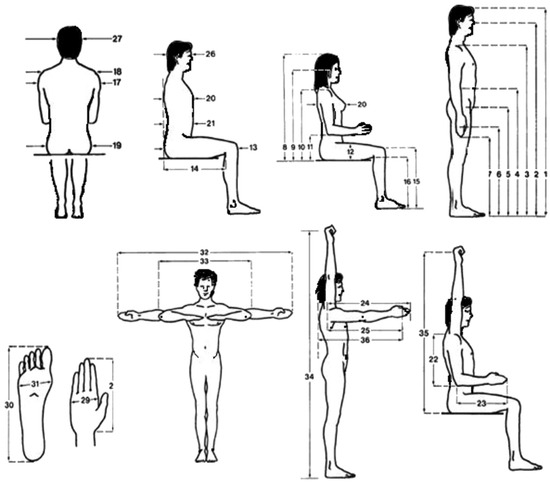
Figure 1.
Body measurement in standing and sitting; courtesy of [10].
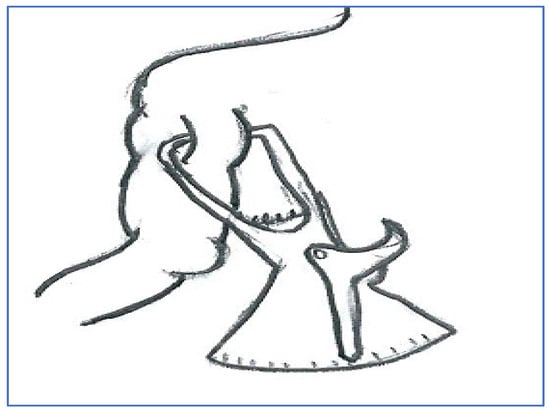
Figure 2.
Triceps skinfold measurement.
2.4. Equipment
It is worth noting that there are a variety of methods for measuring body dimensions for equipment design. Some of these approaches, such as three-dimensional scanners, are costly, complex, and not accessible to all researchers; others, such as traditional anthropometric equipment, are simple and inexpensive. Furthermore, traditional measures yielded anthropometric data that showed no difference from that obtained through 3D scanners [52]. In this study, A RossCraft Anthropometric kit, which includes calipers, a segmometer, tapes, a stadiometer, and a skinfold caliper, was used to measure body dimensions as shown in Figure 3.
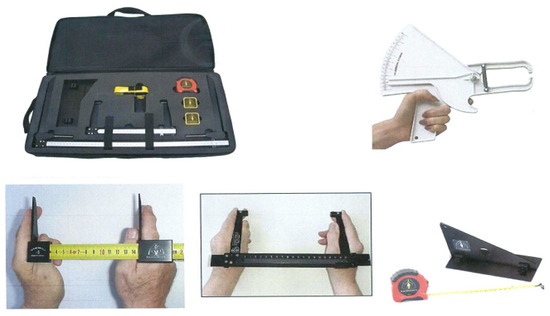
Figure 3.
Anthropometry equipment used for body measurements.
2.5. Procedure
Two female experimenters were trained to become accustomed to the measurement tools and procedures according to the standards described in ISO7250 [41]. The female experimenters are students who have successfully completed a course in ergonomics, which covered three laboratory experiments focused on collecting anthropometric measurements within a class of 130 students. Additionally, they underwent a supplementary five-day training program to enhance their proficiency in conducting measurements on subjects and to evaluate and ensure the inter-measurer reliability of their assessments.
A comprehensive reliability study on all anthropometric measurements for 20 subjects was conducted. Each participant underwent two sets of measurements, ensuring a minimum of 25 degrees of freedom in accordance with the guidelines established in [53]. The focus of the investigation involved both intra-rater and inter-rater reliability, evaluating the consistency within each experimenter’s measurements and the agreement between different experimenters, respectively. The minimum Intraclass Correlation Coefficient (ICC) for intra-rater reliability was found to be 0.88. Simultaneously, the inter-rater reliability study also yielded a minimum ICC of 0.82.
The precision and applicability of anthropometric instrument measurements were ensured by following the guidelines outlined in reference [54] for calipers. These recommendations contain the proper assembly of the device, careful dimension taking, and accurate recording of measurements. Standardization protocols were implemented to address concerns related to misalignment and the applied force during measurements. For skinfold caliper measurements and device calibrations, accuracy was achieved by adhering to the guidelines set forth by the RossCraft recommendations [55].
The subjects were fully informed of the measurement procedure and the purpose of the study. The experimenters located the body landmarks and used proper tapes or calipers to take the measurements. Measurements were always taken on the right-hand side of the individuals to achieve more scientific uniformity. Except for the measures of skinfold thickness, which were taken three times (average is recorded), only one measurement was recorded per body dimension. Standing posture measurements were collected while the subject was standing straight against a wall, as shown in Figure 4. For the sitting posture measurements, each subject was sitting in an upright position on an adjustable horizontal surface seat with their knees bent at 90 degrees and their feet touching the floor. Measurements were taken to the nearest millimeter and were recorded in centimeters, except for the skin fold, which was measured and recorded in millimeters. Subjects were barefooted and wearing light clothing during the measurement process. Normally, the investigators worked in a private room to provide the subject with the most preferable environment. All subjects were provided with a non-disclosure agreement to safeguard their names. Thus, all participants signed an informed consent form.
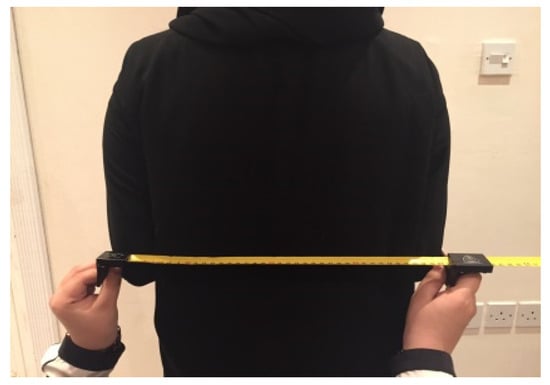
Figure 4.
Technicians measuring participants’ body dimensions.
2.6. Data Analysis
Statistical analysis of the data was performed with SPSS software version 23 (SPSS Inc., Chicago, IL, USA). In all analyses, p-values < 0.05 were considered statistically significant. Tukey’s test was used to determine the significant effect of age group on the body dimensions. The normality of data was tested using the Shapiro–Wilk test.
3. Results
In total, measurements of 38 anthropometric dimensions, including weight and triceps skinfold, were recorded for 504 Saudi females in both sitting and standing postures. Descriptive statistics, including the mean and standard deviation, are provided for each age group in both standing and sitting positions. These statistical summaries are presented in Table 1, Table 2, Table 3 and Table 4, which also include the standard error of the mean (SEM) and the coefficient of variation (CV). Furthermore, to evaluate the health indicators of Saudi females, Relative Sitting Height (RSH = sitting height/stature), Body Mass Index (BMI = body weight (kg) divided by squared stature (m)), and Body Surface Area (BSA = 0.007184 × (Height(cm)^0.725) × (Weight(kg)^0.425)) are computed using the gathered data. The outcomes for each group are presented in Table 5.

Table 1.
Anthropometric data for Saudi Arabia females, aged 20–29 years (n = 126).

Table 2.
Anthropometric data for Saudi Arabia females, aged 30–39 years (n = 126).

Table 3.
Anthropometric data for Saudi Arabia females, aged 40–49 years (n = 126).

Table 4.
Anthropometric data for Saudi Arabia females, aged 50–70 years (n = 126).

Table 5.
BMI, RSH, and BSA for Saudi Arabia female age groups.
4. Discussion
This study provides anthropometric data for the Saudi female population. The presented percentile values serve as valuable references for guiding safe product and various workplace designs, particularly for Saudi females, who have recently become extensively engaged in the workforce. Depending on anthropometric data from other populations may result in mismatches that could potentially lead to adverse health effects. It is imperative to consider factors such as gender, age, ethnicity, and occupation to align the designs of products, environments, and systems holistically.
4.1. Comparison of Anthropometric Data for Saudi Females by Age Group
The Tukey test was performed to determine the differences between age groups for all body dimensions. We only presented the analysis results of body dimensions that were significant. Results showed that age groups have a significant effect on the stature height, eye height, chest depth, skinfold (mm), sitting height, buttock–knee length, and hip breadth of the participants. Table 6 illustrates the effects of age groups on stature height, eye height, chest depth, skinfold (mm), sitting height, buttock–knee length, and hip breadth. In the post hoc analysis, the age groups were grouped to show the significant differences among one another, as shown in Table 7.

Table 6.
One-way analysis of variance of age group measurements.

Table 7.
Post hoc comparison of age groups.
4.2. Comparison of Average Anthropometric Dimensions in Saudi Arabia with Asian Countries
To assess the validity of utilizing anthropometric data from diverse populations as a representation for the Saudi population, a comparative analysis is conducted. This aims to examine the assumption that measurements from various Asian (e.g., Singaporean [6], Indonesian [38], Thai [4], Taiwanese, Chinese, Japanese, and Korean [56]), Middle Eastern (including Iranians [10], Egyptians [57], and Omanis [58]), and European (specifically British [33]) populations might be suitable for estimating Saudi anthropometric dimensions. The results of this comparison are presented in Table 8, providing insights into potential variations in anthropometric profiles among these populations.

Table 8.
Anthropometric body dimensions of female adults in different Asian populations.
In the comparison of weight, Middle Eastern females exhibit higher weight than other populations, with Omani females ranking highest and Saudi females following closely. In contrast, Thai females have the lowest weight among the populations considered. Analyzing body dimensions in a standing posture reveals that Indonesians have the tallest stature and elbow height, while the Japanese and Chinese share the smallest stature, elbow height, eye height, and shoulder height. Singaporeans present the highest eye height and shoulder height. Saudi and Taiwanese females boast the largest knuckle height and chest depth, while Egyptians have the smallest knuckle height, and Thai females exhibit the smallest chest depth.
In the sitting posture, Saudi and Omani females have the lowest sitting height, while Omanis have the smallest sitting eye height, and Egyptians exhibit the smallest elbow rest height. Korean females possess the greatest sitting height, sitting eye height, and elbow rest height. Omani females lead in knee height, and Saudi females have the greatest popliteal height and elbow-to-elbow breadth. Iranians boast the greatest thigh clearance, the British females have the greatest buttock–knee length, and Omanis top the list for the greatest hip breadth. Ethnic disparities in body shape stem from hereditary effects, economic development, social environment, job type, and labor structure.
4.3. Product Mismatch Highlight
To highlight the importance of measuring female dimensions, we investigated the mismatch between workstation design and the body sizes of Saudi females. We investigated the cashier workstations in supermarkets as an example. The cashier career is experiencing increased interest among Saudi females, a shift that was not culturally accepted in the past. Today, many Saudi females are actively working as cashiers in supermarkets. However, the existing mismatch in workstation design presents significant challenges. The combination of high levels of material handling and sustained awkward postures over extended periods poses a heightened risk of developing cumulative trauma disorders [59].
The typical workstation in a supermarket is illustrated in Figure 5. It includes a receiving area with a powered belt, scanner, cash register, and bagging area. Our investigation into the mismatch focuses on the height of the receiving area. The mismatch analysis is based on the method of limits explained in [60]. The working area’s height is segmented into zones, covering unacceptable, acceptable, and optimal ranges. This segmentation is defined by the worker’s elbow height (EH) and the optimum working height criteria presented in [61]. As stated in reference [60], the optimal working height is recommended to be positioned between 50 to 100 mm below the elbow height (EH). Additionally, two other criteria, EH-50 and EH-150, are considered acceptable [60]. These specifications are illustrated in Figure 6.

Figure 5.
A typical supermarket workstation layout.
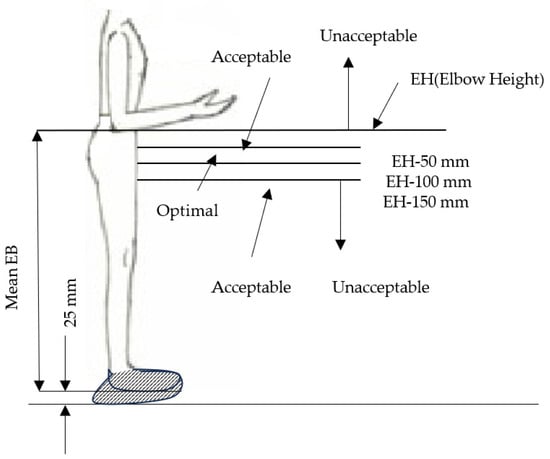
Figure 6.
Criteria for optimal and acceptable working heights.
The elbow height for Saudi females is detailed in Table 1, Table 2, Table 3 and Table 4. Assuming a normal distribution for elbow height, the four regions outlined by the four criteria are also presumed to follow a normal distribution. Using elbow height data from Saudi females across all age groups and considering the insignificance of differences in elbow height between age groups, the mean and standard deviation of Saudi female elbow height while standing are calculated to be 1004 mm and 61 mm, respectively. Accounting for a 25 mm shoe height, the normal distribution for the four criteria is established as shown in Table 9. To assess the mismatch, we examine a commonly used exported commercial cashier station found in various supermarkets, with a height of the receiving area of approximately 900 mm. The results, outlined in Table 9, reveal the percentage distribution of the Saudi female population across each region, considering the receiving area’s height as set at 900 mm. The calculations indicate that 37% of female cashiers will find the height much too low, 68% will find it too low, 10% will find it too high, and 2% will find it much too high, while only 28% will find it comfortable. It is worth noting that a mere increase in height of only 50 mm will result in a 10% rise in the percentage of Saudi females within the comfort zone. According to [59], the optimal working area height should be the average elbow height plus 75 mm, which, in the case of Saudi females, is approximately 1080 mm.

Table 9.
Percentage of Saudi females accommodated by 900 mm supermarket receiving area height.
It is evident from the preceding discussion that there is a clear necessity for anthropometric measurements to prevent any mismatch between product design, work layout, and body dimensions, thereby avoiding adaptations that could lead to musculoskeletal disorders. Ignoring these anthropometric considerations poses a significant risk and jeopardizes the working safety of Saudi females.
5. Conclusions
Anthropometric data of Saudi females aged 20–70 years were surveyed and presented in standard anthropometric tables. Thirty-eight different body size variables, including skinfold, were measured. The studied age domain was divided into four age groups. Statistical analyses were utilized to determine the changes in the body sizes across the age groups. It was found that the age groups have significant differences in Stature Height, Eye Height, Chest Depth, Skin Fold, Sitting Height, Buttock–Knee Length, and Hip Breadth, and the anthropometric tables were constructed based on the data collected from age 20 to age 70. Moreover, The Saudi females’ body dimensions were compared with similar populations from other Asian nationalities. It was found that Saudi females are different in many body measurements than their Asian female counterparts, which supports the necessity of developing an anthropometric database for different Saudi populations. The study is believed to be the first anthropometric study in the age domain of 20–70 for the female population in Saudi Arabia.
These results are expected to fill a gap in the anthropometric research in the country. This study is expected to be utilized in the design process to design products or systems that safely fit Saudi working females. Moreover, the skinfold study is expected to establish a base for healthcare professionals for evaluating Saudi females’ health. The study faced challenging problems due to cultural restrictions in recruiting females to participate voluntarily in the study. This study is expected to drive researchers at the national level to continue working in the area to include other groups of the Saudi population and to investigate larger sample sizes.
6. Limitations
A wider anthropometric data collection will be necessary to increase the representation of the entire Saudi Arabia population in the future. Another limitation of our study is that it was only undertaken in one city, the capital, although the capital usually contains residents representing all parts of the country due to the availability of services and job opportunities.
Funding
The author extends his gratitude to the Office of Research & Innovation at Alfaisal University for funding and supporting this research, grant number IRG 20101181112.
Institutional Review Board Statement
The study was conducted in accordance with the Declaration of Helsinki, and approved by the Institutional Review Board (or Ethics Committee) of Alfaisal University (protocol code IRB-20037)and 17 December 2012).
Informed Consent Statement
Informed consent was obtained from all subjects involved in the study.
Data Availability Statement
Data are contained within the article.
Conflicts of Interest
The author declares no conflicts of interest.
References
- Khadem, M.M.; Islam, M.A. Development of anthropometric data for Bangladeshi male population. Int. J. Ind. Ergon. 2014, 44, 407–412. [Google Scholar] [CrossRef]
- Zaki, N.M.; Husin, S.C.; Husain, M.A.; Husain, N.A.; Ma’aram, A.; Jusuf, A.; Kassim, K.A. Development of anthropometric database for ASEAN NCAP: A case study of Malaysian children aged 6 years old. J. Soc. Automot. Eng. Malays. 2020, 4, 191–207. [Google Scholar]
- Taifa, I.W.; Desai, D.A. Anthropometric measurements for ergonomic design of students’ furniture in India. Eng. Sci. Technol. Int. J. 2017, 20, 232–239. [Google Scholar] [CrossRef]
- Klamklay, J.; Sungkhapong, A.; Yodpijit, N.; Patterson, P.E. Anthropometry of the southern Thai population. Int. J. Ind. Ergon. 2008, 38, 111–118. [Google Scholar] [CrossRef]
- Mital, A.; Karwowski, W. Workspace, equipment and tool design. In Advances in Human Factors/Ergonomics; Elsevier: Amsterdam, The Netherlands, 1991; Volume 15, p. IX. [Google Scholar]
- Lee, Y.C.; Chen, C.H.; Lee, C.H. Body anthropometric measurements of Singaporean adult and elderly population. Measurement 2019, 148, 106949. [Google Scholar] [CrossRef]
- Islam, M.A.; Asadujjaman, M.; Nuruzzaman, M.; Mosharraf, M. Ergonomics consideration for hospital bed design: A case study in Bangladesh. Ergonomics 2013, 1, 30–44. [Google Scholar]
- Bhattacharjya, B.R.; Kakoty, S.K. A survey of the anthropometric data relating to five ethnic groups in Assam considering gender and ethnic diversity: Application of the data in designing an improvised pedal-operated Chaak. Int. J. Ind. Ergon. 2020, 76, 102927. [Google Scholar] [CrossRef]
- Sims, R. “Design for All”: Methods and Data to Support Designers. Ph.D. Thesis, Loughborough University, Loughborough, UK, 2003. [Google Scholar]
- Sadeghi, F.; Mazloumi, A.; Kazemi, Z. An anthropometric data bank for the Iranian working population with ethnic diversity. Appl. Ergon. 2015, 48, 95–103. [Google Scholar] [CrossRef]
- Castellucci, H.I.; Viviani, C.A.; Molenbroek, J.F.M.; Arezes, P.M.; Martínez, M.; Aparici, V.; Bragança, S. Anthropometric characteristics of Chilean workers for ergonomic and design purposes. Ergonomics 2019, 62, 459–474. [Google Scholar] [CrossRef]
- Botha, W.E.; Bridger, R.S. Anthropometric variability, equipment usability and musculoskeletal pain in a group of nurses in the Western Cape. Appl. Ergon. 1998, 29, 481–490. [Google Scholar] [CrossRef][Green Version]
- Kuehn, B.M. Poorly Designed PPE a Global Problem for Women Health Workers. JAMA 2022, 327, 614. [Google Scholar] [CrossRef] [PubMed]
- Wang, E.M.Y.; Wang, M.J.; Yeh, W.Y.; Shih, Y.C.; Lin, Y.C. Development of anthropometric work environment for Taiwanese workers. Int. J. Ind. Ergon. 1999, 23, 3–8. [Google Scholar] [CrossRef]
- Hanson, L.; Sperling, L.; Gard, G.; Ipsen, S.; Vergara, C.O. Swedish anthropometrics for product and workplace design. Appl. Ergon. 2009, 40, 797–806. [Google Scholar] [CrossRef] [PubMed]
- Castellucci, H.; Viviani, C.; Arezes, P.; Molenbroek, J.; Martínez, M.; Aparici, V.; Dianat, I. Applied anthropometry for common industrial settings design: Working and ideal manual handling heights. Int. J. Ind. Ergon. 2020, 78, 102963. [Google Scholar] [CrossRef]
- Kaewdok, T.; Norkaew, S.; Sirisawasd, S.; Choochouy, N.; Taptagaporn, S. Anthropometric Measurement of Thai Older Farmers for Agricultural Tools and Workplace Design. Designs 2022, 6, 81. [Google Scholar] [CrossRef]
- Bori, G.; Bhattacharyya, N.; Kalita, M. Anthropometric Considerations for Occupational Well-Being of Women Weavers Engaged in Commercial Handloom Weaving. Adv. Intell. Syst. Comput. 2021, 1298, 47–56. [Google Scholar]
- Saremi, M.; Rostamzadeh, S.; Esfahani, M. Hand functionality in dentists: The effect of anthropometric dimensions and specialty. Int. J. Occup. Saf. Ergon. 2022, 28, 1473–1481. [Google Scholar] [CrossRef]
- Rejeki, Y.; Achiraeniwati, E.; As’ad, N.; Hadiid, N. The design of manual packaging work station based on workers’ dimension in beverage industry. IOP Conf. Ser. Mater. Sci. Eng. 2020, 830, 042014. [Google Scholar] [CrossRef]
- Redmond, J.; Cohen, B.; Haven, C.; Pierce, J.; Foulis, S.; Frykman, P.; Canino, M.; Sharp, M. Relationship of Anthropometric Measures on Female Trainees’ and Active Duty Soldiers’ Performance of Common Soldiering Tasks. Mil. Med. 2020, 185, 376–382. [Google Scholar] [CrossRef]
- Coltman, C.; Steele, J.; Spratford, W.; Molloy, R. Are female soldiers satisfied with the fit and function of body armour? Appl. Ergon. 2020, 89, 103197. [Google Scholar] [CrossRef]
- Coltman, C.; Brisbine, B.; Molloy, R.; Steele, J. Effect of torso and breast characteristics on the perceived fit of body Armour systems among female soldiers: Implications for body Armour sizing and design. Front. Sports Act. Living 2022, 4, 821210. [Google Scholar] [CrossRef] [PubMed]
- Hsiao, H. Association of anthropometric characteristics of law enforcement officers with perceived ratings of fit, comfort, and pain in the use of body armor. Ergonomics 2023. [Google Scholar] [CrossRef] [PubMed]
- Zhang, S.; Wang, H.; Wang, Y.; Yu, M.; Yuan, J. Association of Rotating Night Shift Work with Body Fat Percentage and Fat Mass Index among Female Steelworkers in North China. Int. J. Environ. Res. Public Health 2021, 18, 6355. [Google Scholar] [CrossRef] [PubMed]
- Kozey, J.W.; Brooks, C.J.; Dewey, S.L.; Brown, R.C.; Howard, K.A.; Drover, D.; McCabe, J. Effects of human anthropometry and personal protective equipment on space requirements. Occup. Ergon. 2009, 8, 67–79. [Google Scholar] [CrossRef]
- Thariq, M.M.; Munasinghe, H.P.; Abeysekara, J.D. Designing chairs with mounted desktop for university students: Ergonomics and comfort. Int. J. Ind. Ergon. 2010, 40, 8–18. [Google Scholar] [CrossRef]
- Nicholas, D.; Huntington, P.; Williams, P. Establishing metrics for the evaluation of touchscreen kiosks. J. Inf. Sci. 2001, 27, 61–71. [Google Scholar] [CrossRef]
- Qader, M.A.; Zaidan, B.B.; Zaidan, A.A.; Ali, S.K.; Kamaluddin, M.A.; Radzi, W.B. A methodology for football players selection problem based on multi-measurements criteria analysis. Measurement 2017, 111, 38–50. [Google Scholar] [CrossRef]
- Tavana, M.; Kazemi, M.R.; Vafadarnikjoo, A.; Mobin, M. An artificial immune algorithm for ergonomic product classification using anthropometric measurements. Measurement 2016, 94, 621–629. [Google Scholar] [CrossRef]
- Chandna, P.; Deswal, S.; Chandra, A. An anthropometric survey of industrial workers of the northern region of India. Int. J. Ind. Syst. Eng. 2010, 6, 110–128. [Google Scholar] [CrossRef]
- Marklin, R.W.; Saginus, K.A.; Seeley, P.; Freier, S.H. Comparison of anthropometry of US electric utility field-workers with North American general populations. Hum. Factors 2010, 52, 643–662. [Google Scholar] [CrossRef]
- Pheasant, S.T. Anthropometric estimates for British civilian adults. Ergonomics 1982, 25, 993–1001. [Google Scholar] [CrossRef] [PubMed]
- Ali, İ.; Arslan, N. Estimated anthropometric measurements of Turkish adults and effects of age and geographical regions. Int. J. Ind. Ergon. 2009, 39, 860–865. [Google Scholar] [CrossRef]
- Huang, C.; You, M. Anthropometry of Taiwanese women. Appl. Ergon. 1994, 25, 186–187. [Google Scholar] [CrossRef] [PubMed]
- Jarosz, E. Anthropometry of elderly women in Poland: Dimensions for design. Int. J. Ind. Ergon. 2000, 25, 203–213. [Google Scholar] [CrossRef]
- Chuan, T.K.; Hartono, M.; Kumar, N. Anthropometry of the Singaporean and Indonesian populations. Int. J. Ind. Ergon. 2010, 40, 757–766. [Google Scholar] [CrossRef]
- Syuaib, M.F. Anthropometric study of farmworkers on Java Island, Indonesia, and its implications for the design of farm tools and equipment. Appl. Ergon. 2015, 51, 222–235. [Google Scholar] [CrossRef] [PubMed]
- Mugisa, D.J.; Katimbo, A.; Sempiira, J.E.; Kisaalita, W.S. Anthropometric characteristics of female smallholder farmers of Uganda–Toward design of labor-saving tools. Appl. Ergon. 2016, 54, 177–185. [Google Scholar] [CrossRef] [PubMed]
- Zein, M.; Baruji, M.E.; Tanb, E.G.L. Anthropometric of Adult Workers at Kota Kinabalu, Sabah, Malaysia. J. Occup. Saf. Health 2021, 27, 177–185. [Google Scholar]
- ISO/TR 7250-2; Basic Human Body Measurements for Technological Design-Part 2: Statistical Summaries of Body Measurements from National Populations. International Organization for Standardization: Geneva, Switzerland, 2010.
- Nadadur, G.; Raschke, U.; Parkinson, M.B. A quantile-based anthropometry synthesis technique for global user populations. Int. J. Ind. Ergon. 2016, 53, 167–178. [Google Scholar] [CrossRef]
- General Authority of Statistics. Labor Market Statistics Q3, 2022 (Excel File). 2022. Available online: https://www.stats.gov.sa/en/814 (accessed on 18 December 2023).
- Haboubi, M. Anthropometric Study for the User Population in Saudi Arabia. In Proceedings of the 11th Congress International Ergonomics Association, Paris, France, 15–20 July 1991; pp. 891–893. [Google Scholar]
- Al-Hazzaa, H.M. Anthropometric measurements of Saudi boys aged 6–14 years. Ann. Hum. Biol. 1990, 17, 33–40. [Google Scholar] [CrossRef]
- Alrashdan, A.; Alsudairi, L.; Alqaddoumi, A. Anthropometry of Saudi Arabian female college students. In Proceedings of the IIE Annual Conference, Montreal, QC, Canada, 31 May–3 June 2014; p. 4075. [Google Scholar]
- Alrashdan, A.; Ghaleb, A.M.; Almobarek, M. Normative Static Grip Strength of Saudi Arabia’s Population and Influences of Numerous Factors on Grip Strength. Healthcare 2021, 9, 1647. [Google Scholar] [CrossRef] [PubMed]
- Qotba, H.; Naser Al-Isa, A. Anthropometric measurements and dietary habits of schoolchildren in Qatar. Int. J. Food Sci. Nutr. 2007, 58, 1–5. [Google Scholar] [CrossRef] [PubMed]
- Musaiger, A.O.; Al-Ansari, M.; Al-Mannai, M. Anthropometry of adolescent girls in Bahrain, including body fat distribution. Ann. Hum. Biol. 2000, 27, 507–515. [Google Scholar] [PubMed]
- International Standards Organization 15535 General Requirements for Establishing Anthropometric Databases. 2006. Available online: https://www.iso.org/standard/44067.html (accessed on 27 November 2023).
- Lee, W.; Jung, K.; Jeong, J.; Park, J.; Cho, J.; Kim, H.; Park, S.; You, H. An anthropometric analysis of Korean male helicopter pilots for helicopter cockpit design. Ergonomics 2013, 56, 879–887. [Google Scholar] [CrossRef] [PubMed]
- Sims, R.; Marshall, R.; Gyi, D.; Summerskill, S.; Case, K. Collection of anthropometry from older and physically impaired persons: Traditional methods versus TC2 3-D body scanner. Int. J. Ind. Ergon. 2012, 42, 65–72. [Google Scholar] [CrossRef]
- Oliver, G.; Rushton, A. A study to explore the reliability and precision of intra and inter-rater measures of ULNT1 on an asymptomatic population. Man. Ther. 2011, 16, 203–206. [Google Scholar] [CrossRef] [PubMed]
- Osquei-Zadeh, R.; Rousta-Nezhad, M. Novel design of a usable and accurate anthropometric caliper. Int. J. Occup. Environ. Med. 2012, 3, 126–135. [Google Scholar]
- Johnston, B. Anthropometry: A General Introduction Featuring Rosscraft Innovations Instruments. Available online: https://cursos.drdegirolami.com/wp-content/uploads/2021/05/Intro_antropometria.pdf (accessed on 18 December 2023).
- Lin, Y.C.; Wang, M.J.J.; Wang, E.M. The comparisons of anthropometric characteristics among four peoples in East Asia. Appl. Ergon. 2004, 35, 173–178. [Google Scholar] [CrossRef]
- Moustafa, A.; Davies, B.; Darwch, M.; Ibraheem, M. Anthropometric study of Egyptian women. Ergonomics 1987, 30, 1089–1098. [Google Scholar] [CrossRef]
- Khadem, M. Anthropometric study of Omani female population age between 15–57 years in 2014. Int. J. Syst. Ind. Eng. 2017, 26, 527–548. [Google Scholar] [CrossRef]
- Orgel, D.L.; Milliron, M.J.; Frederick, L.J. Musculoskeletal discomfort in grocery express check stand workers; an ergonomic intervention study. J. Occup. Med. 1992, 34, 815–818. [Google Scholar] [CrossRef] [PubMed]
- Pheasant, S. Bodyspace. Anthropometry, Ergonomics and Design; Taylor & Francis: London, UK, 1988. [Google Scholar]
- Grandjean, E. Fitting the Task to the Man: A Textbook of Occupational Ergonomics, 4th ed.; Taylor & Francis: London, UK, 1988. [Google Scholar]
Disclaimer/Publisher’s Note: The statements, opinions and data contained in all publications are solely those of the individual author(s) and contributor(s) and not of MDPI and/or the editor(s). MDPI and/or the editor(s) disclaim responsibility for any injury to people or property resulting from any ideas, methods, instructions or products referred to in the content. |
© 2024 by the author. Licensee MDPI, Basel, Switzerland. This article is an open access article distributed under the terms and conditions of the Creative Commons Attribution (CC BY) license (https://creativecommons.org/licenses/by/4.0/).